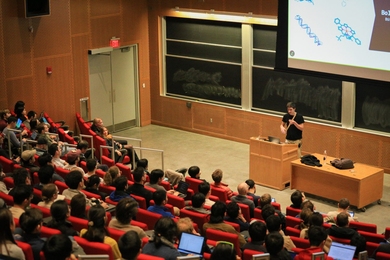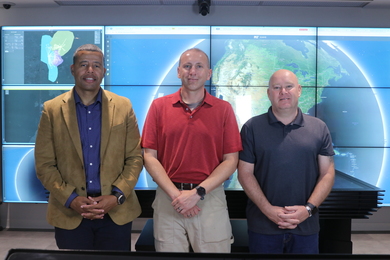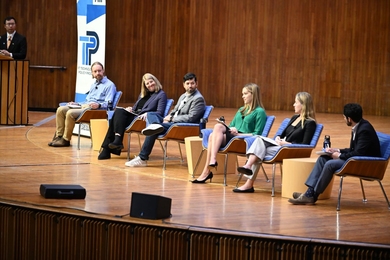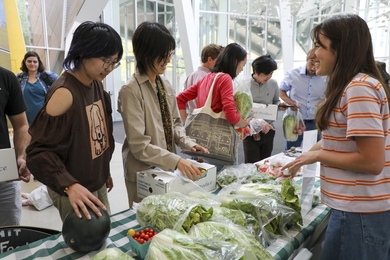Some 500 research directors from companies around the world now understand first-hand the oft-used analogy that getting an education from MIT is like taking a drink from a firehose.
For two days last week at the Industrial Liaison Program's 1998 Research Directors Conference, participants listened to research highlights from all five of MIT's schools and several laboratories. In addition, five concurrent sessions Wednesday afternoon presented 20 projects in more detail.
This year's conference marked the ILP's 50th anniversary. Karl F. Koster, acting director of the MIT Office of Corporate Relations, noted that when the ILP was formed in 1948, it had six member companies. Now it has 200 from around the world.
SLOAN SCHOOL
One theme echoed by several speakers was the importance of research collaborations between MIT's schools. "This is one of MIT's real advantages," said Thomas J. Allen, deputy dean for the Sloan School of Management and the Howard W. Johnson Professor of Management. The Program on the Pharmaceutical Industry, for example, brings together researchers from the schools of management, engineering, science, and humanities and social science.
One project in that program involves looking at ways of making the clinical testing process more efficient. Currently that process "makes up the majority of costs in drug development," said Professor Allen. He also described research aimed at discovering what effect various medications (such as those for allergies) have on worker productivity. The work is based on productivity data and health records for about 3,000 insurance workers.
Professor Allen also emphasized the importance of industrial collaborations to MIT research. "If you were to attend a meeting of MIT's Lean Aerospace Initiative, you'd see people in industry making research presentations alongside MIT students and faculty. The goal is to increase the bidirectional technology transfer," he said.
SCHOOL OF ENGINEERING
Imagine highlighting, in 25 minutes, the research and educational initiatives for a school with eight departments and some 20 laboratories, programs and centers. John B. Vander Sande, associate dean of the School of Engineering and a professor in the Department of Materials Science and Engineering, was faced with that challenge.
Among his comments: the School is listening to industry feedback about its students. For example, he noted that industry "tells us MIT students are brilliant, but don't know how to work in teams. They also aren't always the best communicators, either orally or in writing." The School is instituting curriculum changes to address such issues.
Swinging over to research, Professor Vander Sande described projects including the development of molecularly engineered films of materials only one atomic layer thick. That work is led by Professor Paul Laibinis of chemical engineering.
ARCHITECTURE AND PLANNING
A slide of a weathering Buddha was key to Professor Bernard J. Frieden's description of one research project in the School of Architecture and Planning. The image was actually a computer simulation by Julie Dorsey, associate professor of design and computational and building technology, showing how a new statue would weather with time. Such simulations, which can also be applied to building facades and other architectural features, could be a useful tool to architects who want to know, in advance, what their creations will look like in the future.
Dr. Frieden, associate dean of the school and Ford Professor of Urban Development, also described studies of how cities use publicity to advance themselves and particular projects. That work, by Professor Lawrence Vale of urban studies and planning, will be the focus of a faculty seminar this fall.
Professor Frieden concluded with a project he himself is working on: issues surrounding the closing of military bases and their conversion to airports and other private-sector facilities. "It is not yet clear whether the bases ought to be considered a bonus from the end of the Cold War or the 'yard sale at the end of history' -- unwanted property, available only to buyers willing to make their way through a maze of bureaucratic obstacles," he said.
HUMANITIES AND SOCIAL SCIENCE
"Who would have thought that MIT would become one of the world's great centers for the study of Shakespeare?" said Philip S. Khoury, dean of the School of Humanities and Social Science and a professor of history. Yet that is indeed the case, due to an MIT program for the study and interpretation of the bard's plays via multimedia technology.
Professor Khoury also described an award-winning project for learning languages in which interactive multimedia stories "totally immerse a student in the language and culture" of the main character. For example, in "A la rencontre de Philippe," the first of the series, students help Philippe navigate around Paris.
"The student is no longer just sitting in the language lab passively absorbing French," Professor Khoury said. The researchers have also developed programs for German, Japanese, Spanish and soon Chinese.
Both the Shakespeare and language programs were developed through the school's Laboratory for Advanced Technology in the Humanities.
SCHOOL OF SCIENCE
An experiment going up on the space shuttle on June 2 will search for a phenomenon predicted but as yet unseen by physicists: antimatter. The experiment, a particle physics detector known as the Alpha Magnetic Spectrometer, is led by Nobel laureate Samuel Ting, the Thomas Dudley Cabot Professor of Physics at MIT.
The AMS was one of the projects that Robert J. Birgeneau, dean of the School of Science and Cecil and Ida Green Professor of Physics, shared with his audience as an example of the cutting-edge research being conducted through the school.
"In addition to the matter that makes up you and me, there should be antimatter, the exact complement of matter," explained Professor Birgeneau. Similarly, "just as we have a universe made of matter, it's equally likely that there are universes of antimatter with antipeople. So where are these other universes?"
To find out, Professor Ting and colleagues designed AMS to look for "remnants of antiuniverses created at the same time our universe was created."
Professor Birgeneau noted that even if AMS does not provide evidence for antimatter, there has never been such a high-resolution detector in space before. "So I guarantee that interesting things will be observed."
LAB FOR COMPUTER SCIENCE
Will it rain in Boston tomorrow? Where is it snowing in the US today? Those were two of the questions asked of Jupiter, a computer telephone interface for weather information, at a live demonstration of the technology. The demonstration was part of Victor W. Zue's talk on research highlights from the Laboratory for Computer Science (LCS).
To access Jupiter, a user calls an 800 number and can query the system about the weather in 500 cities worldwide. The technology is part of LCS efforts to allow humans to converse with machines. LCS "conversational interfaces" are emerging that, among other things, "deal with continuous speech by unknown users, have a vocabulary of thousands of words, and handle multiple languages (English, Spanish and Mandarin Chinese)," said Dr. Zue, LCS associate director and a senior research scientist.
And for those who are wondering: on the day of the demo (May 6), it was snowing in Alaska and North Dakota.
Other speakers at the May 6 morning sessions of the conference were J. David Litster, vice president for research, dean for graduate education and professor of physics; Andrew B. Lippman, associate director of the Media Laboratory and a lecturer in the Program in Media Arts and Sciences; and Vincent W. S. Chan, head of the Communications and Information Technology Division at Lincoln Laboratory.
Speakers on May 7 were Daniel Roos, associate dean for systems engineering and a professor in the Department of Civil and Environmental Engineering; Emilio Bizzi, the Eugene McDermott Professor in the Brain Sciences and Human Behavior; Rosalind W. Picard, the NEC Development Professor of Computers and Communications and associate professor of media technology in the Media Lab; Michael S. Scott Morton, the Jay W. Forrester Professor of Management at the Sloan School; and Warren P. Seering, the Weber-Shaughness Professor of Mechanical Engineering and director of the Center for Innovation in Product Development.
Imagine highlighting, in 25 minutes, the research and educational initiatives for a school with eight departments and some 20 laboratories, programs and centers. John B. Vander Sande, associate dean of the School of Engineering and a professor in the Department of Materials Science and Engineering, was faced with that challenge.
Among his comments: the School is listening to industry feedback about its students. For example, he noted that industry "tells us MIT students are brilliant, but don't know how to work in teams. They also aren't always the best communicators, either orally or in writing." The School is instituting curriculum changes to address such issues.
Swinging over to research, Professor Vander Sande described projects including the development of molecularly engineered films of materials only one atomic layer thick. That work is led by Professor Paul Laibinis of chemical engineering.
A version of this article appeared in MIT Tech Talk on May 13, 1998.





